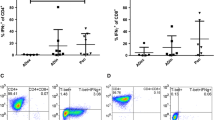Abstract
Atopic dermatitis is a disease with a genetic predisposition affecting the immune system, with T lymphocytes participating in the immune dysregulation. Most in vitro T lymphocyte studies of atopic dermatitis have focused on antigen-specific T-cell clones. However, antigen-non-specific regulatory T lymphocytes may also take part in the pathway leading to antigen-specific clonal T-lymphocyte proliferation. T lymphocytes from skin biopsy specimens from three patients with severe atopic dermatitis were cultured in the presence of IL-2 and IL-4, but without antigen added. Initially, proliferation was oligo- or polyclonal, but in all cases overgrowth by T cells with clonal chromosomal aberrations was subsequently observed. These abnormal T-cell clones demonstrated continuous growth and complete or partial phenotypic loss of the T-cell antigen receptor complex. In summary, these findings suggest that a subset of aberrant skin-homing T lymphocytes is associated with atopic dermatitis.
Similar content being viewed by others
References
Bos JD, Wierenga EA, Smitt JHS, van der Heijden FL, Kapsenberg ML (1992) Immune dysregulation in atopic eczema. Arch Dermatol 128: 1509–1512
Cooper KD (1994) Atopic dermatitis: recent trends in pathogenesis and therapy. J Invest Dermatol 102: 128–137
Jensen AW, Hokland M, JØrgensen H, Justesen J, Ellegaard J, Hokland P (1991) Solitary expression of CD7 among T-cell antigens in acute myeloid leukemia: identification of a group of patients with similar T-cell receptor Β and δ rearrangements and course of disease suggestive of poor prognosis Blood 78: 1292–1300
Perillo NL, Walford RL, Newman MA, Effros RB (1989) Human T lymphocytes possess a limited in vitro life span. Exp Gerontol 24: 177–187
Pawelec G, Schneider EM, Wernet P (1986) Acquisition of suppressive activity and natural killer-like cytotoxicity by human alloproliferative “helper” T cell clones. J Immunol 136: 402–411
Reinhold U, Kukel S, Goeden B, Neumann U, Wehrmann W, Kreysel H-W (1991) Interleukin-4 promotes the expansion of skin-infiltrating lymphocytes from atopic dermatitis in vitro. J Invest Dermatol 96: 370–375
Kaltoft K, Bisballe S, Dyrberg T, Boel E, Rasmussen PB, Thestrup-Pedersen K (1992) Establishment of two continuous T-cell strains from a single plaque of a patient with mycosis fungoides. In Vitro Cell Dev Biol 28A: 161–167
Kaltoft K, Bisballe S, Sterry W, SØgaard H, Thestrup-Pedersen K (1994) Sezary syndrome is characterized by genotraumatic T-cells. In: Vloten WA van, Lambert WC (eds) Basic mechanisms of physiologic and aberrant lymhoproliferation in the skin. Plenum Press, New York, pp 401–418
Kaltoft K, Holm Hansen B, Thestrup-Pedersen K (1994) Cytogenetic findings in cell lines from CTCL. Dermatol Clin 12: 295–304
Author information
Authors and Affiliations
Rights and permissions
About this article
Cite this article
Kaltoft, K., Pedersen, C.B., Hansen, B.H. et al. In vitro genetically aberrant T-cell clones with continuous growth are associated with atopic dermatitis. Arch Dermatol Res 287, 42–47 (1994). https://doi.org/10.1007/BF00370717
Received:
Issue Date:
DOI: https://doi.org/10.1007/BF00370717




